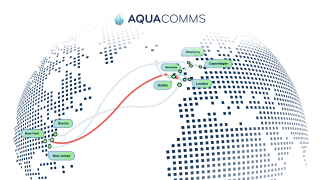The last year has seen a number of major carrier names add so-called “global Ethernet” services to their product portfolios. It seems that you’re not really in the big leagues any more unless you’re able to deliver Ethernet over a seriously wide area.
Global Crossing can claim with some justification to have an edge in Ethernet as a global transport mechanism. It was back in the early part of the last decade when its first carrier Ethernet service saw the light of day, providing enterprise and carrier customers with a link between key PoPs in places like London and Frankfurt.
“Carrier Ethernet has been an important part of the Global Crossing portfolio for many years,” claims Jeff Smith, Global Crossing’s senior director of infrastructure services EMEA. Late 2009 saw the company’s Ethernet offer formalised as a truly global service with the launch of Ethersphere – a Layer 2 managed service able to run between multiple locations over MPLS, at speeds from 1Mb to 1Gb.
“Ethersphere services really enable our enterprise and carrier customers to extend their service and network reach to meet the needs of the global marketplace,” says Smith. The idea from the start, he says, was that Ethersphere would uphold the same level of support and functionality that carrier customers are receiving from more traditional TDM-based services.
Carrier Ethernet, says Smith, is now embedded throughout Global Crossing’s wide area network strategy: “Ethersphere’s Layer 2 Ethernet WAN and our Layer 3 IP VPN work together to meet the needs of service providers’ multi-site, multinational enterprise customers,” he says.
Other elements to the Global Crossing wholesale Ethernet offer include Etherline point to point managed services, typically used, says Smith, as either a “long line” LAN extension service between customer locations or as a PoP to PoP service for service provider customers. Then there is Global Crossing Bespoke Ethernet which is, as the name suggests, an individually designed private Ethernet service. It can be hosted on privately installed fibres between premises, or one of Global Crossing’s metropolitan fibre networks, or on national optical wavelengths, or on any combination of the three.
“I think what’s different about Global Crossing’s Ethernet portfolio is their international focus,” says Rena Bhattacharyya, research manager for enterprise telecoms services at analyst firm IDC. “When they rolled out Ethersphere, they didn’t take the usual route of launching it domestically first and then internationally, they went straight for international.”
There were, says Bhattacharyya, a number of more or less simultaneous carrier announcements about international VPLS availability in the latter part of 2009: “But there were only a handful of service providers doing it to any sizeable degree,” she says. “Global Crossing was one, and announced theirs even before Verizon. They may be quite a bit smaller than some of the big carriers, but they have a good product portfolio.”
Another distinguishing feature of Global Crossing’s Ethernet strategy is its willingness to extend Ethernet beyond the obvious comfort zone of north America and Europe and into markets where such a thing is in its early stages of roll out, such as Latin America.
That Global Crossing has extended Ethernet connectivity to Latin America is interesting, if not exactly surprising, says Bhattacharyya: “It is of course one of their key markets,” she says. “The corporates they serve are looking for a proper global portfolio, of equal quality everywhere. If you’re claiming to be serving Latin America, you’d better be offering as good a service there as elsewhere.”
Smith anticipates that Ethernet can only continue to grow in importance as a global standard, and thus will stay at the heart of Global Crossing’s WAN offer: “At the moment, most businesses have Ethernet-based local area networks but growing pressures on data storage and bandwidth are continually forcing them to re-evaluate their networks,” he says. “Scaling up the systems already in place is costly, time-consuming and realistically, only a short-term solution. Instead, companies should look at extending the Ethernet network beyond the LAN. This will help them gain greater performance, flexibility and reliability and importantly, at a relatively low cost.”
From a technical perspective, he says Global Crossing has found that Ethernet integrates well with other broadband transport methods, extending the life of existing network investments as needed to cost-effectively connect multiple sites to each other and to the internet.
“In addition, because Ethernet wide area transport is IP-compatible, companies can take advantage of IP applications – such as hosted telephony, VoIP, business intranets and extranets, network security and disaster recovery – which are much more difficult to deploy over the more traditional networks,” he explains. “This has a very positive effect on productivity, business resilience and overall network management. For this reason, Ethernet services will continue to play a significant role in Global Crossing’s overall vision of a fully packetised transport network.”




